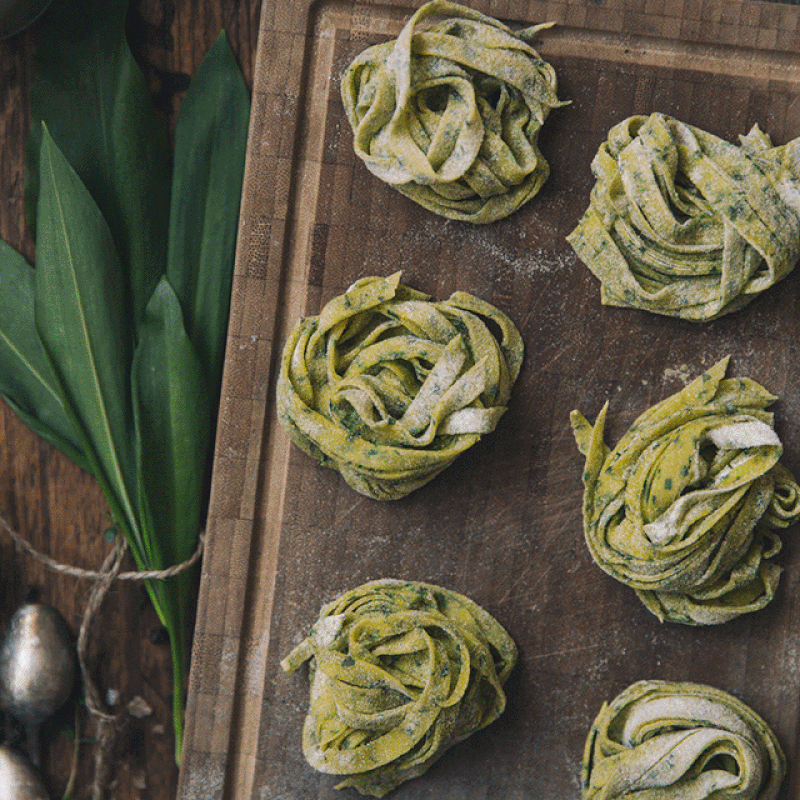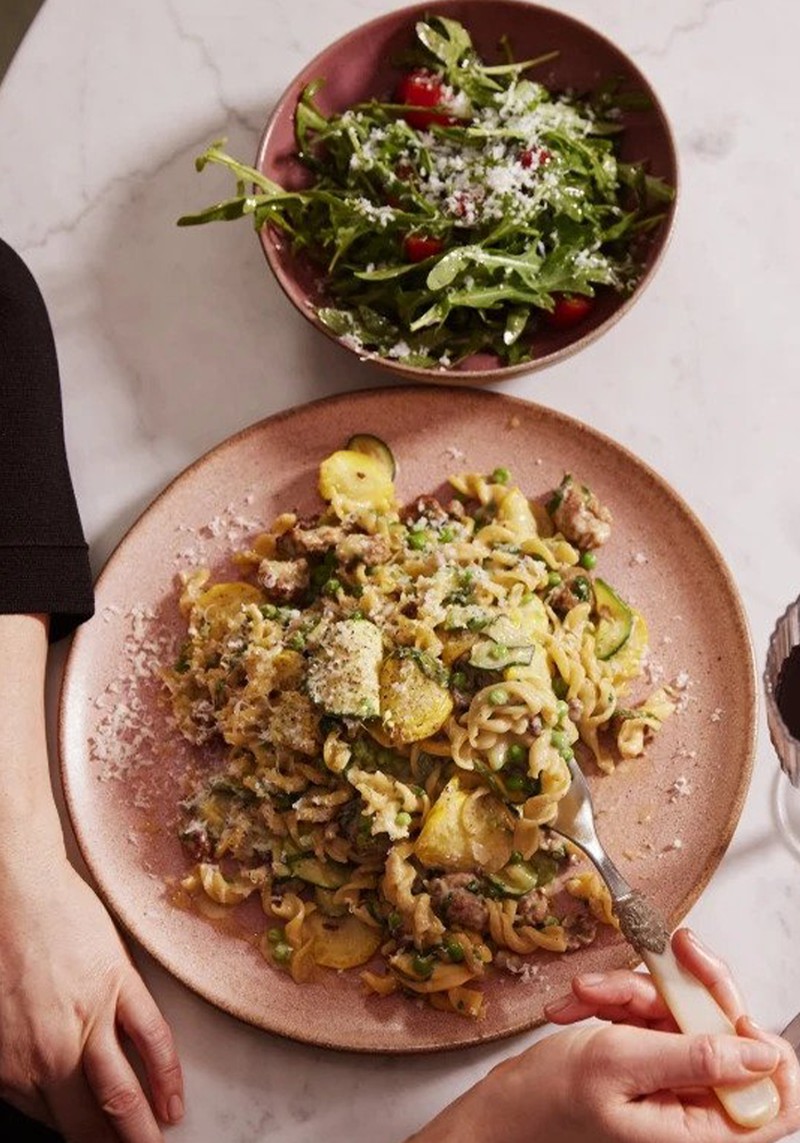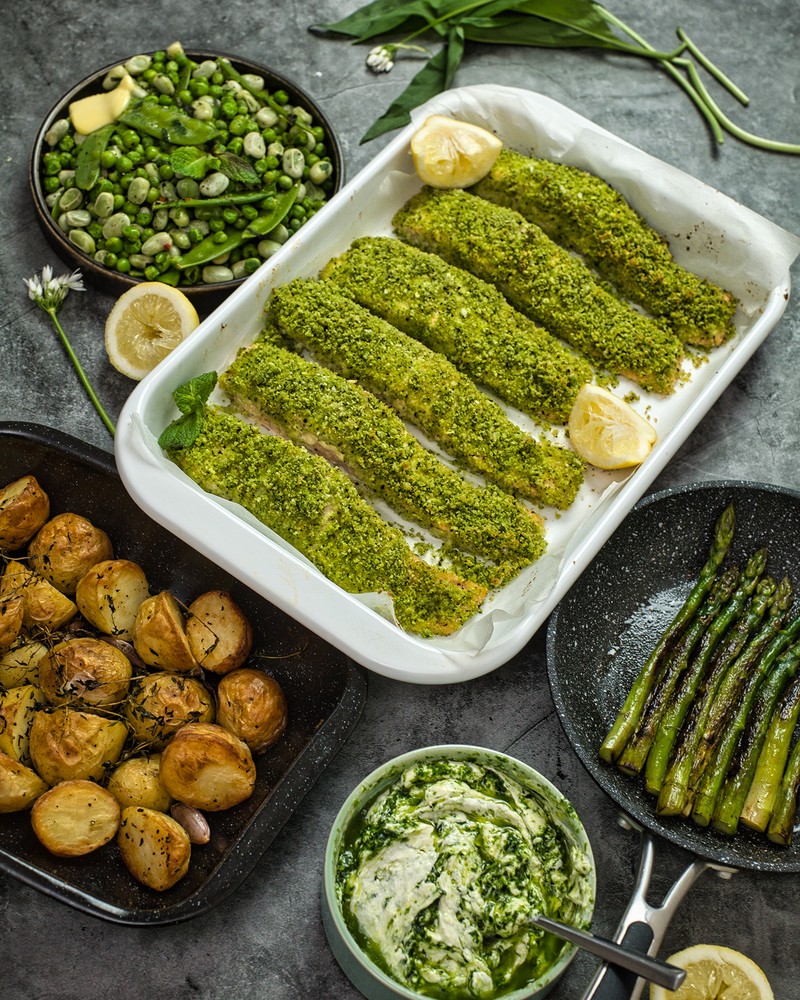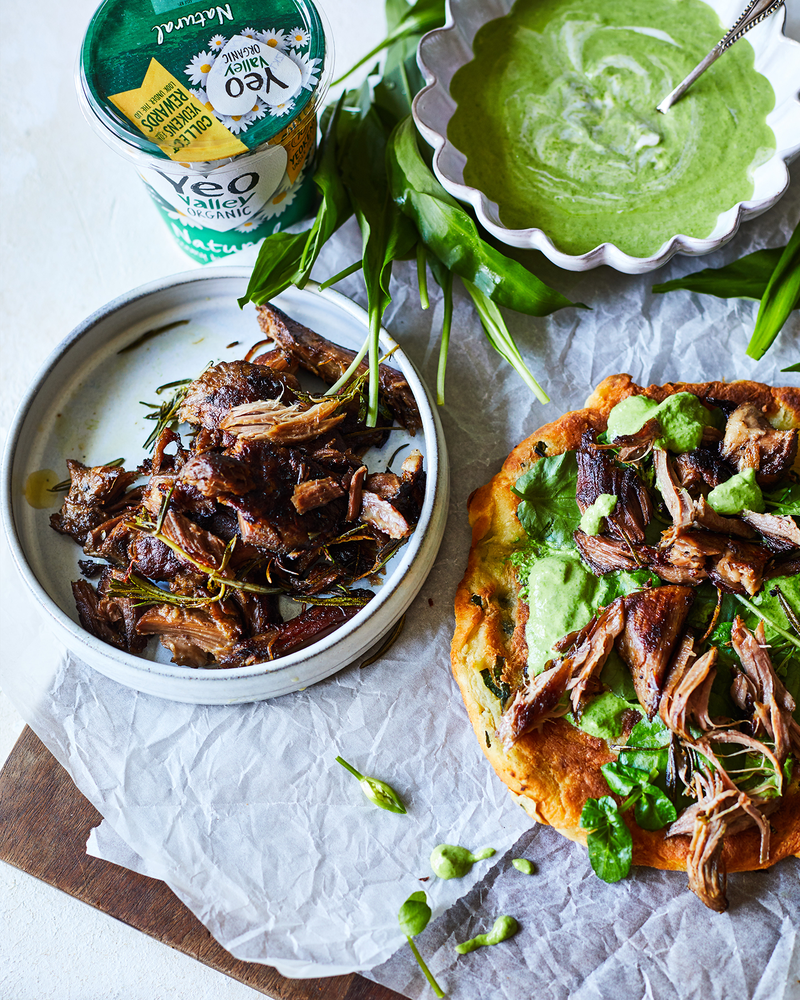How To Make The Most Of Wild Garlic Season
Andrew Clarke, Pilot Light
Where’s the best place to find wild garlic?
Growing up in Kent meant I had a good choice of woodland nearby so I could harvest the broad green leaves and stellar white flowers. From the beginning of April until the beginning of June, the woods would fill with a heady aroma of allium. The plant grows in abundance, for as far as the eye can see. Hunting and finding your own fresh garlic is best. Damp woodlands are the best places to hunt them down, but my closest spot these days is a north London cemetery. Otherwise, your local grocers should sell it.
And what’s the best way to prepare it?
Once picked, it stores well wrapped in kitchen roll in an airtight container in the fridge. There’s so much you can do with wild garlic: it’s really versatile. You can roughly chop leaves and fold through salads or tortillas and omelettes; finely chop it into crushed or roasted baby potatoes; wrap up with fish in steamed parcels; or use it to replace soft herbs or spinach. The flowers make attractive garnishes for spring dishes and later in the season, when the petals fall from the plant, you have the bulbils, which chefs often refer to as ‘ramson capers’. Preserve these in a pickling vinegar or brine for use throughout the year.
Have you got a favourite recipe?
I love making wild garlic, feta and hazelnut pesto. It’s great served as a dip for vegetables, or as a sauce for grilled fish or meat. Blend 400g of wild garlic leaves, 4 tbsp of feta, 2 tbsp of roasted hazelnuts 1 tbsp of crème fraiche (or Greek yoghurt), 100ml of olive oil and half a lemon in a food processor, then season to taste. You could leave out the feta and serve with a ball of burrata instead – just drizzle the oil over for a striking finish
Visit ChefAndrewClarke.com
Adrian Martin, Wildflower
Are there different types of wild garlic?
There are dozens of very similar plants called 'wild garlic'. The one we see most commonly grows in woodlands as a floor covering of white blooms. The leafed cousin, ‘ransom’, is more of a hedge dweller and you will see its delicate blooming beauty lining the roads of England in late spring.
Is it possible to grow your own?
Wild garlic will grow well in gardens but can takeover if not trimmed to tame it. If you would like a crop for next spring, simply plant a few of the bulbs in a semi-shady area, water well and you will be rewarded next year. Be sure to pick your parent bulbs from a verge or hedge and not a protected forest or nature reserve.
Any tips for foraging?
When picking your wild garlic, be sure to only pick healthy, undamaged specimens and ensure to wash before using. Use kitchen scissors used to snip the garlic off at the base are the best. Ideally you would harvest garlic away from traffic and pollution for cleaner plants. Check that it is wild garlic by using the smell test: it is unmistakable.
Visit WildflowerRestaurant.co.uk
Ivan Tisdall-Downes, Native
How can you identify wild garlic in the wild?
You’ll probably smell the wonderful aroma before you see it. Then, depending on the time of year, you’ll spot their beautiful dainty white petals (there are six petals on each flower) and their deep green, spear shaped leaves towards the end of the season. Usually found under a leafy, damp woodland canopy in early spring, once you find a spot, you'll enjoy its bountiful goods year on year. Just remember to only ever take one fifth of the plant – leave the majority to bloom, flower and continue for years to come. You can never be too careful when foraging, so never be complacent, and always double-check each plant is wild garlic, as there are similar ones which are poisonous. These do not smell like garlic, so they are easily identifiable.
Where can you buy it?
You can buy it online via Abel and Cole plus at smaller, local farm shops and farmers’ markets.
Tell us the best way to prepare it…
Give it a good rinse in cold water and brush off any dirt, and make sure you use the vibrant, green and healthy-looking leaves, not the wilted ones.
And any favourite wild garlic recipes you can recommend?
Wild garlic pesto is a great way to enjoy the fresh, powerful flavours – at Native we use a mixture of nettles, wild garlic, hazelnuts, rapeseed oil and a hard cheese from Neal's Yard Dairy. It’s a quick and delicious way to enjoy with pasta or a bruschetta for lunch. You can make the pesto and freeze in ice cube trays ready to defrost for a weekday dinner. A potato salad made with finely shredded wild garlic leaves and plenty of creamy butter is a great addition to any BBQ.
Visit EatNative.co.uk
Lucy Carr-Ellison & Jemima Jones, Wild By Tart
Where do you buy your wild garlic?
We buy from Parkway Green in Camden Town, but you should be able to find it at your local greengrocers and Natoora.
What's the best way to cook it?
We love making marinades from it and whizzing it into pesto (which keep well jarred in the fridge), or adding the freshly chopped leaves to spring soups, pastas, stews, salads and sandwiches. It’s also great whizzed into butter and kept in the freezer for whenever you need a good hit through the rest of the year. To make a tasty marinade for white fish on the BBQ, whizz two handfuls of wild garlic, one of handful parsley, one handful of basil, the juice and zest of 1 lemon, 3 spring onions, 100ml of olive oil, a pinch of sea salt and a pinch of red chilli together in a blender. Score the fish and slather on the marinade. Allow to marinate for a couple of hours before hitting the hot grill.
Patrick Powell, Allegra
If you wanted to pick your own wild garlic, where in London would you suggest?
Try Springfield Park which is just north of the Queen Elizabeth Olympic Park and Hackney Marshes. Otherwise, try the Hoxton Fruit & Veg Shop – it has everything.
Can you eat it raw?
It’s too strong to eat raw, so gently soften in a pan to mellow the flavour. I like to blitz it through leek and potato soup right at the end with loads of black pepper. Serve with a poached egg.
Visit Allegra-Restaurant.com
Inspired? Here are five more recipes to try at home…
Wild Garlic Risotto With Lemon & Ricotta: Danilo Cortellini, MasterChef: The Professionals
Start with the wild garlic puree. Rinse and pat dry the wild garlic, discarding the very large and bulky, stalks. Once dry, quickly blanch in salted boiling water the garlic until soft. This will take no longer than 1 minute. Now blitz the garlic in a food processor adding a bit of the cooking water if necessary. You are looking for a puree/paste consistency so be careful with the liquid and don’t stress too much if the paste is grainy – that is the beauty of a rustic recipe.
Gently fry the chopped onion in a small pan with a drizzle of extra virgin olive oil and a pinch of salt for about 10-15 minutes on low heat, until well golden and caramelised. Keep to one side.
In a large casserole, start to toast the rice on a low heat with a pinch of salt, without adding oil or fat. Keep stirring the rice, so the rice does not catch on the bottom of the pan or burn. When the rice is very hot, pour the white wine in. Let the alcohol evaporate, set the cooking time to 15 minutes and add the simmering stock a ladle at a time, little by little. Stir the rice occasionally, and keep cooking.
Halfway through the cooking, add the caramelised onion to the rice and wild garlic puree and keep stirring. At this stage you want to check if the ricotta is too watery, as it could mess with the texture of the risotto. Get rid of the water by draining it with a colander. Once the cooking time of the risotto is up, if you’re happy with the texture remove it from the heat.
The last step is called ‘mantecatura’ – with the right movements you can make the risotto creamier and increase its natural ooziness. Add the grated grana padano cheese and butter to the rice and stir with energy to incorporate extra air until the risotto is nice and creamy. Season to taste and add a splash of lemon juice.
Plate the hot risotto and top with lemon zest, with chunks of fresh ricotta on optional a few basil leaves.
Visit DaniloCortellini.com
Fennel Sausage, Courgette, Pea & Wild Garlic Fusilli: Gizzi Erskine for ZENB
Begin by squeezing the sausage meat out of its skin and break it up into clumps and clusters. Heat the oil in frying pan over a high heat, and fry off the sausage meat with the chilli flakes until well caramelised, crisp and golden.
Next, add the courgettes and fry off for a minute or so until slightly softened, and then add the peas.
Cook the fusilli according to the packet instructions (I like an al dente texture).
In a bowl, mix together the crème fraîche, egg yolks, parmesan and tablespoon or two of pasta water.
Add to the sausage mixture, along with the cooked pasta and wild garlic. Stir through gently until the pasta is evenly coated in the glossy, silky sauce.
Season with salt and plenty of black pepper.
Visit ZENB.co.uk
Wild Garlic Crumbed Salmon: Nitisha Patel, award-winning chef & food consultant
Start by marinating the salmon. Mix together the olive oil, lemon juice, and freshly ground salt and pepper. Gently toss the salmon fillets through the marinade and leave refrigerated for 1 hour.
While the salmon is marinating, prepare the wild garlic crumb. Blitz the breadcrumbs in a food processor until fine, add in the wild garlic and blitz until they have completely broken down for form a green crumb. Transfer the crumb into a wide bowl (wide enough for 1 salmon fillet to lay flat at a time), pour in the melted butter, and gently fold through. Shake the bowl so that the crumb mixture is even and flat.
Once the salmon has had 1 hour of marinating, remove from the fridge, and preheat your oven to 200°C. Brush a large baking tray with 2 tbsp of vegetable oil to grease and leave aside.
Combine the smaller amount of crème fraîche with the English mustard. Lay the marinated salmon fillets on a tray or plate (flat-side down) and brush the top of the fillets with the crème fraîche and mustard mixture.
Using clean hands pick up a fillet of salmon and dip the coated side into the wild garlic crumb so that the flesh side is pressed into the crumb. Lay the fillet (on the flat, uncoated side), on your greased baking tray so that the crumb is facing upwards. Repeat until all 6 fillets are crumbed.
Bake the salmon in your preheated oven for 8 minutes.
While the salmon is baking, prepare the wild garlic crème fraiche. Using a food processor or liquidiser, blitz down the wild garlic, olive oil and lemon juice until smooth. Transfer to a mixing bowl and fold in the crème fraiche to create a marbled dip.
Serve the baked wild garlic crumbed salmon with new potatoes and spring green vegetables.
Visit NitishaPatel.com
Lamb With Wild Garlic Yogurt & Flatbreads: Yeo Valley
In a large bowl mix together all the ingredients for the yoghurt flatbreads until it just comes together. Make into about 250g balls and squish out with your hands until they roughly fill the base of a medium-sized frying pan. Add 1 tbsp of olive oil to a hot pan and gently fry for 8-10 minutes on each side.
Pull the lamb apart and add to a frying pan along with the olive oil and rosemary sprigs. Fry until the edges start to go crispy and caramelised.
Meanwhile add the wild garlic, olive oil, salt and 50g of yoghurt to a blender and blitz until smooth. Mix through the remaining yoghurt and put in a dish to serve.
Serve in the middle of the table ready for everyone to tuck in and share.
Visit YeoValley.co.uk
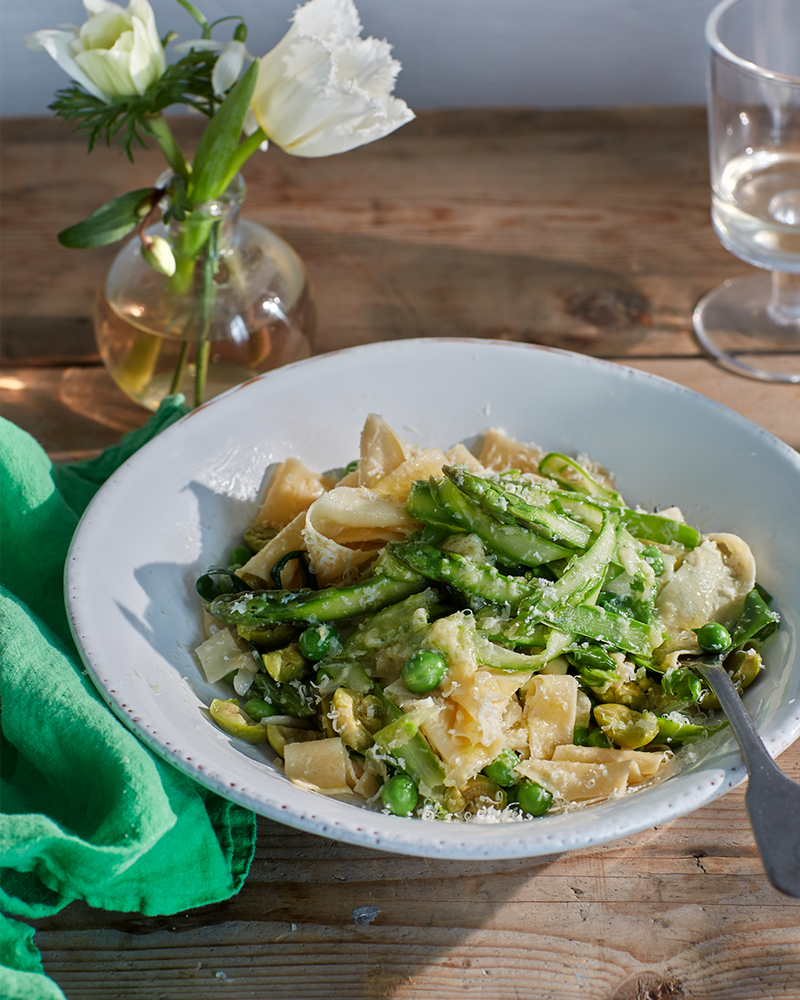
Fresh Pasta With Asparagus & Wild Garlic: Daylesford
Prepare the asparagus by cutting the spears vertically into long, thin strips with a sharp knife, vegetable peeler or a mandolin.
Set a sauté pan over a medium heat and add a little olive oil. Add the shallot and sweat for 2 minutes. Once softened, add the asparagus strips and season with salt & pepper. Continue to cook for a further 2 minutes.
Bring a large pan of salted water to the boil. Drop in the pasta and swirl around with a wooden spoon to stop it from sticking. When the pasta is nearly done but still has some bite, lift it from the water with tongs and transfer to the sauté pan with the softened shallots and asparagus. Do not discard the pasta cooking water.
Toss the pasta together with the asparagus and shallot, adding a handful of cheese, the wild garlic and peas.
Return the sauté pan to a low-medium heat. Add a ¼ cup of the pasta cooking water and a handful of cheese, tossing the pan as you go over a low heat so the sauce does not split. Repeat until all the cheese has melted and you have a glossy sauce. Once you are happy with the consistency, divide the pasta between two serving plates. Top with a final sprinkling of cheese or chopped olives and enjoy.
Visit Daylesford.com
DISCLAIMER: We endeavour to always credit the correct original source of every image we use. If you think a credit may be incorrect, please contact us at info@sheerluxe.com.
